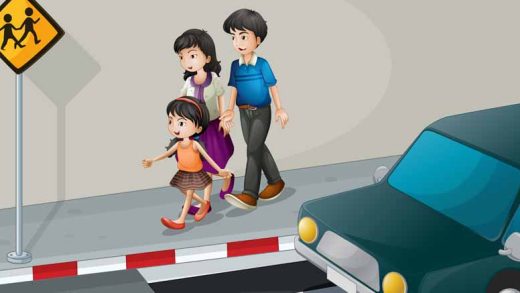‘So Near, yet so Far away!’
The above is a phrase commonly used by adults, in describing something that’s out of their reach, even though it is physically close. Or perhaps, when describing a game that they were close to winning. One that slipped out of reach, at the last moment.
Literally speaking, however, things that are Near are close to us, and things that are Far, at a distance!
Teaching children that they cannot ‘physically’ hold the Sun in their hands, even though they might form a circle with their fingers and pretend they are, is not easy. Most preschoolers are still testing the waters of what is Near and what is Far.
So, how do you explain the Near and Far Concept to Kids? In this article we will examine how children can develop a sound understanding of what is Near and what is Far. This will be backed with some cool Near and Far Examples.
But first, let’s get ‘Nearer’ to our understanding of the concept of Near and Far
Near and Far: The Concept, Explained
The concept of Near and Far can be better understood by taking a look at each of its individual components.
Near
This essentially means that the object in question is a ‘short’ distance away from the point of reference.
Far
In this case, the object being observed is at a ‘long’ distance away from the point of reference.
Near Point and Far Point (h3)
Now that we have gotten a basic understanding Of Near and Far, it’s time to get oriented with the terms ‘Near Point’ and ‘Far Point.’
Near Point
This refers to the minimum distance of the object from the human eye, from where it can be seen clearly, and without any sort of strain.
Cool Fact: Generally speaking, in the case of a normal human eye, the Near Point is 25 cm.
Note: The above does not hold true when a person has Hypermetropia. This is a condition of the eye, in which close objects cannot be seen properly. Hence, the Near Point extends to beyond 25 cm.
Far Point
This refers to the maximum distance from which the object can be perceived clearly by the naked eye, with no strain.
Cool Fact: It’s incredible to know that for a normal human eye the Far Point is ‘Infinity’!
Note: Again, there is an eye condition called Myopia, where the above does not hold true. In Myopia, distant objects cannot be seen clearly, thus dropping the Far Point to lower than Infinity.
Near and Far Examples for Preschoolers
Preschoolers are least concerned with the Near Point and Far Point. All they want to know is what lies Near them, and what is Far away.
The following is one of the simplest Near and Far Examples for children, that will help them understand the concept of Near and Far, with relative ease.
The Three-Object Method
Want to teach kids what is Near and what is Far? All you need are ‘three objects’ that can be locally sourced from the environs of your house!
To do: In this instance, consider that the objects are a pen, a notepad and a laptop. Place the laptop on the centre of a desk, and the pen at a short distance away on one side. Then, place the notepad at a greater distance from the laptop, on its other side
Now call your child, and tell them that the Pen is ‘Near’ the Laptop, while the Notepad, ‘Far’ from it.
Near and Far Concept: Nearest and Farthest
With the preceding example, your children will gain a basic understanding of what is Near and Far.
However, how do we explain the terms ‘Nearest’ and ‘Farthest’ to them?
To do: Once again, we can use 3 objects to understand what objects are ‘Nearest’ us, and those that are ‘Farthest.’ In this case, let’s take a Ball, a Toy and a Plastic Bottle, and go outdoors. Let’s place the ball at the greatest distance away from us. The toy needs to be at a lesser distance away, and the plastic bottle, at the least distance.
Now, call your child and ask them to stand alongside you. Explain to them, that the Ball is the Farthest away from them, and the Plastic Bottle, the Nearest.
Near and Far Activities for Preschoolers
Let’s reinforce the Near and Far Concept in the minds of children, with some cool Near and Far Activities.
The ‘Bye’ and ‘Goodbye’ Game
Goodbyes are only reserved for people who are going Far away!
To do: This game is preferably played in the Outdoors, where there is plenty of Space. Tell your child that when you say ‘Bye’ to them, they must go a ‘short distance’ away from you, before stopping. In other words, ‘Near’ you. Conversely, when you tell them ‘Goodbye’, they have to go a long distance away from you. That is, ‘Far’ away.
Fetch the Nearest and Farthest Object
This one can be played in any of the rooms of your home!
To do: Sit alongside your child, before asking them to get the object in the room that is ‘Nearest’ to them. After they have brought it to you, tell them to get the Object that is ‘Farthest’ from them. This will help succinctly drill the concept of Near and Far in their mind.
Worksheet Fun: Circling Near and Far Objects
Children love circling on Worksheets, be it at home or in restaurants!
To do: Take a printout of different objects from our everyday lives. Example: House, Car, Plane, Sun. Ask your child to only circle the objects that are Near them! Needless to say, the others are the ones that are Far away.
At Kangaroo Kids, we believe that learning about the concepts of Near and Far, makes for an essential learning practice for Kids. It helps them get a better sense of what objects in the environment are Near and Far from them. Further, it helps them identify the distances between two objects.









